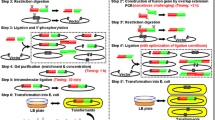Abstract
Gene splicing by fusion PCR is a versatile and widely used methodology, especially in synthetic biology. We here describe a rapid method for splicing two fragments by one-round fusion PCR with a dual-asymmetric primers and two-step annealing (ODT) method. During the process, the asymmetric intermediate fragments were generated in the early stage. Thereafter, they were hybridized in the subsequent cycles to serve as template for the target full-length product. The process parameters such as primer ratio, elongation temperature and cycle numbers were optimized. In addition, the fusion products produced with this method were successfully applied in seamless genome editing. The fusion of two fragments by this method takes less than 0.5 day. The method is expected to facilitate various kinds of complex genetic engineering projects with enhanced efficiency.




Similar content being viewed by others
References
Yamashita, M., Xu, J., Morokuma, D., Hirata, K., Hino, M., Mon, H., et al. (2017). Characterization of recombinant thermococcus kodakaraensis (kod) dna polymerases produced using silkworm-baculovirus expression vector system. Molecular Biotechnology, 59(6), 1–13.
Brinster, R. L., Chen, H. Y., Trumbauer, M., Senear, A. W., Warren, R., & Palmiter, R. D. (1981). Somatic expression of herpes thymidine kinase in mice following injection of a fusion gene into eggs. Cell, 27, 223–231.
Yon, J., & Fried, M. (1989). Precise gene fusion by PCR. Nucleic Acids Research, 17, 4895.
Swiech, L., Heidenreich, M., Banerjee, A., Habib, N., Li, Y., Trombetta, J., et al. (2015). In vivo interrogation of gene function in the mammalian brain using CRISPR-Cas9. Nature Biotechnology, 33, 102–106.
Zaslaver, A., Liani, I., Shtangel, O., Ginzburg, S., Yee, L., & Sternberg, P. W. (2015). Hierarchical sparse coding in the sensory system of Caenorhabditis elegans. Proceedings of the National Academy of Sciences, 112, 1185–1189.
Szewczyk, E., Nayak, T., Oakley, C. E., Edgerton, H., Xiong, Y., Taheri-Talesh, N., et al. (2006). Fusion PCR and gene targeting in Aspergillus nidulans. Nature Protocols, 1, 3111–3120.
Liu, Y., Yang, M., Chen, J., Yan, D., Cheng, W., Wang, Y., et al. (2016). PCR-based seamless genome editing with high efficiency and fidelity in Escherichia coli. PLoS ONE, 11, e0149762.
Heckman, K. L., & Pease, L. R. (2007). Gene splicing and mutagenesis by PCR-driven overlap extension. Nature Protocols, 2, 924–932.
Sandhu, G. S., Aleff, R., & Kline, B. (1992). Dual asymmetric PCR: One-step construction of synthetic genes. BioTechniques, 12, 14–16.
Nakamura, M., Suzuki, A., Hoshida, H., & Akada, R. (2014). Minimum GC-rich sequences for overlap extension PCR and primer annealing. DNA Cloning and Assembly Methods, 1116, 165–181.
Gibson, D. G., Young, L., Chuang, R.-Y., Venter, J. C., Hutchison, C. A., & Smith, H. O. (2009). Enzymatic assembly of DNA molecules up to several hundred kilobases. Nature Methods, 6, 343–345.
Li, M. Z., & Elledge, S. J. (2007). Harnessing homologous recombination in vitro to generate recombinant DNA via SLIC. Nature Methods, 4, 251–256.
Lohff, C. J., & Cease, K. B. (1992). PCR using a thermostable polymerase with 3′ to 5′exonuclease activity generates blunt products suitable for direct cloning. Nucleic Acids Research, 20, 144.
Liu, Y., Chen, S., Chen, J., Zhou, J., Wang, Y., Yang, M., et al. (2016). High production of fatty alcohols in Escherichia coli with fatty acid starvation. Microbial Cell Factories, 15, 129.
Li, X.-T., Thomason, L. C., Sawitzke, J. A., & Costantino, N. (2013). Positive and negative selection using the tetA-sacB cassette: recombineering and P1 transduction in Escherichia coli. Nucleic Acids Research, 41, e204–e204.
Takagi, M., Nishioka, M., Kakihara, H., Kitabayashi, M., Inoue, H., Kawakami, B., et al. (1997). Characterization of DNA polymerase from Pyrococcus sp. strain KOD1 and its application to PCR. Applied and Environmental Microbiology, 63, 4504–4510.
Acknowledgements
This work was supported by the National Basic Research Program (973 Program, 2011CBA00800).
Author information
Authors and Affiliations
Corresponding author
Ethics declarations
Conflict of interest
The authors declare that they have no conflict of interest.
Electronic supplementary material
Below is the link to the electronic supplementary material.
Rights and permissions
About this article
Cite this article
Liu, Y., Chen, J. & Thygesen, A. Efficient One-Step Fusion PCR Based on Dual-Asymmetric Primers and Two-Step Annealing. Mol Biotechnol 60, 92–99 (2018). https://doi.org/10.1007/s12033-017-0050-7
Published:
Issue Date:
DOI: https://doi.org/10.1007/s12033-017-0050-7




